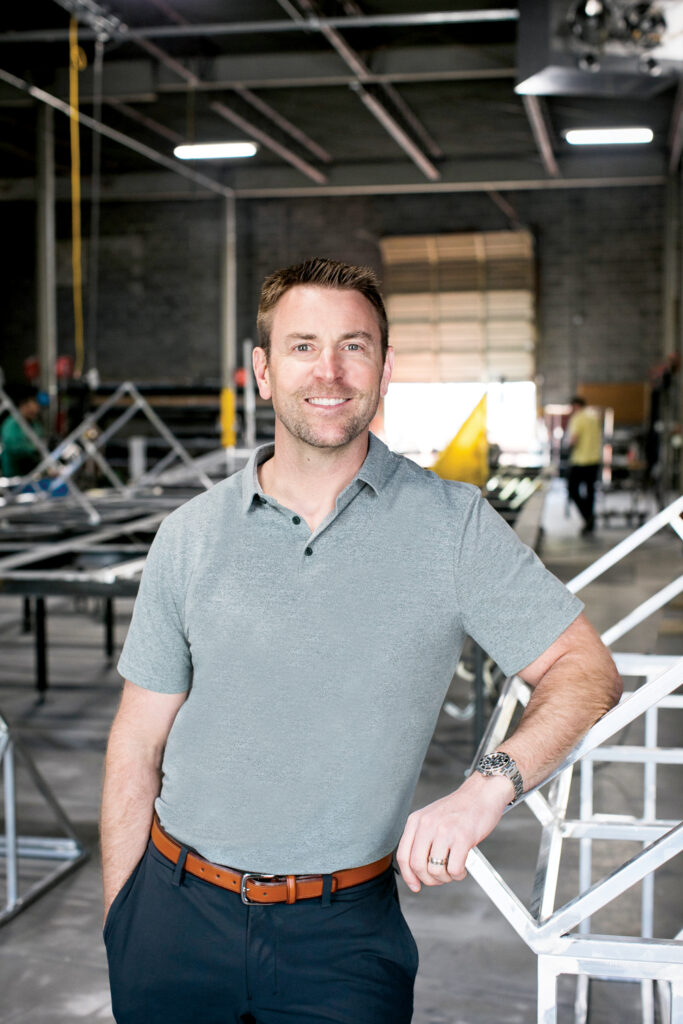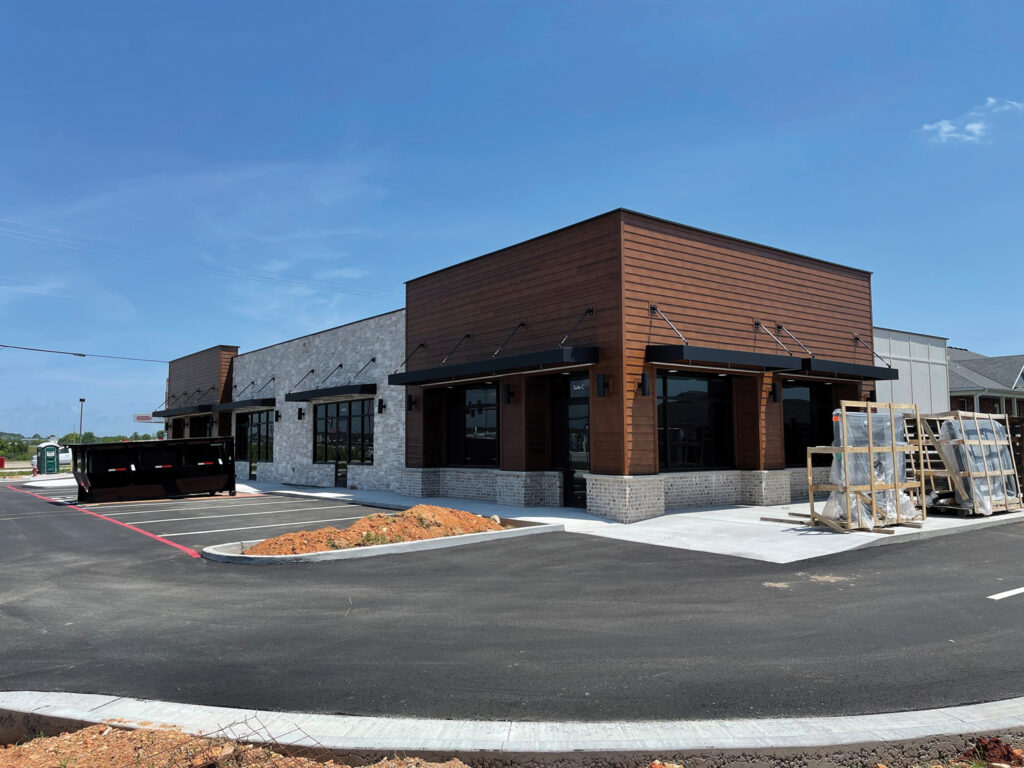
Fifteen years ago, Scott Neville was a newcomer to the shade industry. In partnership with his father, Ron, he has since acquired three renowned awning companies with more than 300 years of combined industry leadership. And he’s just getting started.
An avid challenge-seeker, Neville joined the industry in 2008 in Springfield, Mo. He and his father were exploring business opportunities beyond their real estate ventures when Welhener Awning & Shade, established in 1902 in Ozark, Mo., became available for purchase.
“It checked all the boxes,” recalls Neville, who has a background in construction and engineering. “We were looking for a local opportunity in the construction realm that would not compete in a congested market or against foreign suppliers—something niche that we could have greater freedoms with. And being a part of anything that brings people outside to enjoy the fresh air and avoid UV rays with such colorful style is very rewarding.”
A strategic approach
Money management was an easy hurdle to overcome as new business owners, thanks to Ron’s finance background. Developing effective people management skills required more time and practice. Understanding the industry and its many quirks further steepened the learning curve, but Welhener’s existing membership with the Advanced Textiles Association (IFAI at the time) helped expedite the process; Neville immediately found value in discussing questions and problems with other shade members across the country.
“It’s important for business owners to get their hands dirty in all aspects of sales, design, fabrication and installation. Only then can you spot bottlenecks and other issues in time to act before something negative happens,” he says. “To be the leader in your area, it’s also critical to stay on top of trends and processes; ATA is a great resource for this.”
By 2014, Neville was ready for more. He acquired H.B. Wall Awning, a local competitor also founded in the early 1900s, and the company became Welhener–H.B. Wall Awning. To expand business throughout the Midwest, Neville acquired Kansas City Tent & Awning Co. in Kansas City, Mo., five years later. Its roots date back to 1901. “These companies are over 120 years old and leaders in their geographic areas; the name recognition is incredibly valuable as we continue to deliver and enhance the high-quality products they’re known for.”

Set up for success
Commercial contracts comprise 80% of both businesses, which manufacture and install a wide range of shade structures, including awnings, canopies, patio covers and shade sails. With the exception of accounting, both businesses maintain separate operations and staff groups. Welhener–H.B. Wall Awning has 13 employees and Kansas City Tent & Awning has 17—most of whom were retained after each acquisition. All aspects of production and fabrication are performed in-house.
“Once we had two companies, our first priority was working more efficiently,” Neville says. That included the consolidation of redundant activities, such as accounting, but even more important was establishing a shared vision across teams.
“We were careful to balance the urgency to align on company goals and values with the necessity to make changes gradually and get to know employees on a personal level. We didn’t want anyone to feel like they were going to be micromanaged by an entity hours away, with no real interest in them. Building and maintaining relationships based on trust helps us work together more effectively and efficiently.”
Neville is based in Springfield but spends one day a week at the Kansas City facility for staff meetings and so that he is accessible to all employees. “Every person on our team is critical to the success of our operations,” he says. “They need to hear that consistently from the top down, and I want to be able to have regular discussions with them about their concerns and ideas.”
A remote filing system also contributes to a culture of transparency; employees from both operations can access all project documentation from any location at any time. “Sharing resources has been incredibly beneficial. Each business operates a bit differently and has helped the other learn and grow in new ways.”
As the industry continues to face staffing challenges, ensuring that existing employees feel valued is essential. “We try to promote from within, but getting new people in the door has been a struggle,” Neville says. “I know a lot of people in the industry are in the same boat, so we have to make sure we take care of the employees we have. I give all I am able to give, treat everybody as family and personally help with every problem I am capable of improving.”
Shared commitment
Open communication is a priority for customer relationships as well. Neville brings customers through every step of the design process to help manage expectations. “To be successful, I not only need to listen to the customer’s concerns but share mine as well. We’re hired to help them solve a problem, and we only have one shot to get it right. It’s my job to point out potential issues and focus on the details so they understand what they’re getting and why.”
From conversations with existing customers to outreach among construction companies and architects, Neville is determined to bring more awareness to the benefits of fabric. “If someone inquires about a metal canopy, for instance, I try to solve their problem with fabric right alongside and present that as well. I tell them there’s usually more freedom, the designs are often more interesting and they can simply have more fun with the shapes, colors and angles. Not to mention, fabric performance properties get better every year.”
Neville recently joined the board of ATA’s Professional Awning Manufacturers Association (PAMA) to continue this work on a bigger scale. “We’re all looking to be good stewards of our industry, and I take that role seriously,” he says. “Doing this work together removes the competition barrier and helps increase the market for all of us.”
Pausing to look back at how far he and his team have come helps Neville turn to the future with optimism. “Through difficult times, we have grown almost every year and remain the market leader in our area. That’s an accomplishment the team has worked incredibly hard for; plus, we have a lot of fun doing it,” he says. “Even as the cost of doing business rises, our industry is still needed. We’re an integral part of architectural design, and I’m excited for what’s to come.”
Holly Eamon is a freelance writer based in Eden Prairie, Minn.
Photography by Lindsay J.C. Lack
SIDEBAR: Project snapshot

With fabric, budget meets blueprint
Last summer, Scott Neville and the team at Welhener–H.B. Wall Awning helped a longtime client cut costs and achieve the contemporary look of metal canopies by using modern performance fabrics over a traditional—and more economical—awning frame.
The client, a local developer, designed a commercial building featuring aluminum overhead-supported canopies. Priced as drawn, however, the canopies exceeded the budget. Neville’s fabric-first mindset helped convince the client to mimic the look with fabric instead.
“The overhead support canopy look was integral to this development,” Neville says. “Our plan was to cover a minimalist aluminum skeleton in a performance outdoor fabric and use the same beefy overhead support arms and mounting plates we use on our aluminum canopies.”
Because of the local climate, snow loading was a top consideration as well. “The awnings have very little slope to achieve the look we wanted, so we had to factor in snow loading when determining frame construction. The connection points of the overhead support arms are designed specifically to carry the increased load and distribute their capacity along the whole width.”
The project took about five weeks and 50 yards of black Herculite Weather-Chek®, plus 50 yards of AwnTex® 160 mesh by Glen Raven Custom Fabrics LLC, on the bottom to close it up.
SIDEBAR: Q&A
What critical lesson did you learn as a new business owner in your industry?
Stick to your business plan and what you are good at; don’t play games with the competition for who can be the cheapest or sell product you are not completely invested in. If I could go back, I would have brought more functions in-house sooner than later. Not being 100% in control of every aspect of our product creation did a disservice to the customer and to the industry. This took time to correct. I also learned the importance of “staying in our own yard.” We’re not for every buyer, and we don’t want to be.
As the professionals, we need to be honest with customers and manage expectations to the best of our abilities. A lot of that comes down to being a good, honest businessperson. Chances are, if you just stick to your guns, you’re going to be fine. And you’re probably going to have a lot fewer headaches than if you keep trying to be the answer to everybody’s needs.
 TEXTILES.ORG
TEXTILES.ORG


